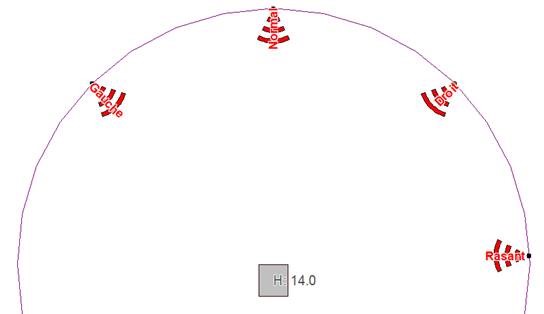|
<< Click to display Table of content >> Indoor methods |
  
|
|
<< Click to display Table of content >> Indoor methods |
  
|
Exemple de comparaison des méthodes de calcul.
Nous travaillons sur un projet théorique (sol plat, …) avec 4 antennes nommées Gauche, Normal, Droit, Rasant.
Example of comparison of calculation methods.
We are working on a theoretical project (flat ground,…) with 4 antennas named Gauche, Normal, Droit, Rasant.

View of the project
On this project, 3 calculations are launched.
Here are the results (in V / m) according to the method for each antenna:
|
Outdoor |
IBGE indoor |
CSTB indoor |
Rasant |
3.05 |
1.07 |
0.16 |
Droit |
2.46 |
1.07 |
1.12 |
Gauche |
2.46 |
1.07 |
1.12 |
Normal |
2.45 |
1.07 |
1.37 |
Comment:
The outdoor level varies due to interference from the reflection of the facade.
With the IBGE 2016 method the level is constant.
With the CSTB 2016 method, the level varies depending on the incidence angle.
n the CSTB 2016 method, the indoor level is calculated like this (online technical documentation):

- WE is the normal incidence loss (in dB)
- ![]() is the incidence angle of the wave with the frontage (0° means normal incidence, 90° means grazing incidence)
is the incidence angle of the wave with the frontage (0° means normal incidence, 90° means grazing incidence)
- WGE the extra loss (in dB) for grazing incidence. WGE is constant and equals 20 dB. WE is deduced from the diffuse field loss factor WD (depending on the frontage material in MithraREM) with the formula WE = WD - 2:15.
Question
A quoi correspond le facteur d'attenuation en dB ? Est-ce un facteur diffus (WD, moyenné pour toutes les directions d'incidence) ou normal (WE, pour une onde incidente normale) ?
Dans MithraREM, la donnée d'entrée de l'interface est toujours l'affaiblissement en champ diffus.
La méthode IBGE applique directement cet affaiblissement au champ incident.
La méthode CSTB prend en compte l'angle d'incidence selon une formule de couverture. La formule permet de faire le lien entre affaiblissement en incidence normale et en champ diffus. Donc on déduit l'affaiblissement en incidence normale à partir de la donnée d'entrée.
Question
What is the attenuation factor in dB? Is it a diffuse factor (WD, averaged for all directions of incidence) or normal (WE, for a normal incident wave)?
In MithraREM, the input to the interface is always the diffuse field loss.
The IBGE method applies this attenuation directly to the incident field.
The CSTB method takes into account the angle of incidence according to a coverage formula. The formula makes it possible to make the link between attenuation in normal incidence and in diffuse field. So we deduce the attenuation at normal incidence from the input data.